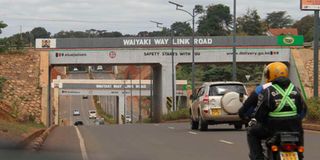Nairobi’s street names; the signposts to history

Waiyaki Way Link Road.
‘What’s in a name?’ Juliet asked, when she was telling her Romeo not to worry about the rivalry between their clans – the Capulets and the Montagues. She was wrong, wasn’t she? Shakespeare’s plot took a more realistic and tragic account of clan conflict.
For some time, I have enjoyed taking note of the history behind many of Nairobi’s street names. So when I see the signposts like Waiyaki Way or General Mathenge Drive, I take to Google to find out why these men deserve to be so celebrated. You can learn a lot about Kenya’s transition years – the struggle for Independence – by checking out such people.
Let me tell you a few of the stories.
I guess most readers will know who the Waiyaki of Waiyaki Way was – the Kikuyu chief who made the wazungu welcome by signing a treaty with Frederick Lugard of the British East Africa Company. But he himself actually went two ways. After a time, he became frustrated at the number of Europeans who were arriving and acquiring land. In 1890, he burnt down Lugard’s fort. Two years later, he drew his sword against a colonial officer, one W P Curtiss, who struck Waiyaki’s head when arresting him. Waiyaki died, presumably of the wound, when on the march to Mombasa to be exiled.
The Harry Thuku Road runs past Nairobi’s Central Police Station – the location where a demonstration took place that led to many deaths. Harry Thuku played a key role in the early African nationalist movements. Because of his activities, the colonial government imprisoned him in March 1922. More than 7,000 of Thuku’s followers gathered to protest. Led by Mary Muthoni Nyanjiru from Murang’a, the crowd surged forward. She had challenged the men who were walking away by lifting her dress above her shoulders and shouting ‘Take my dress and give me your trousers. You men are cowards. What are you waiting for? Our leader is in there! Let’s go and get him!’ In panic, the police fired into the crowd, killing, according to official figures, 21 of the protesters.
General Mathenge Drive was named in honour of one of the most prominent of the Mau Mau freedom fighters. Like many Africans who fought in the Second World War, Stanley Mathenge’s anti-colonial views were honed by meeting activists from other countries and by seeing Europeans in a much less dignified or pampered light. In May 1953, he became the leader of the Mau Mau military unit ‘Nyeri District Council and Army’. He seems to have had a fierce rivalry with Field Marshal Dedan Kimathi. In 1955, General Mathenge disappeared. There are stories that he went to live in Ethiopia, where he is said to have died in 2016.
And now a European name – Dennis Pritt. I have driven the Dennis Pritt Road countless times, and I have assumed he must have been one of the settlers who stayed on. But he is not. He is a British barrister, who had the road named after him as a mark of gratitude for being the lead counsel in representing the Kapenguria Six accused of links with the Mau Mau – Jomo Kenyatta, Bildad Kaggia, Fred Kubai, Achieng’ Oneko, Paul Ngei and Kung’u Karumba.
It seems Pritt had more honour abroad than at home. He was thrown out of the Labour Party in Britain for his open support of the Soviet Union in the early years of the Cold War. George Orwell, author of ‘Animal Farm’, claimed that Pitt was ‘almost certainly an underground communist’. Unpopular in Britain, Pritt went on to be Professor of Law at the University of Ghana.
In one search I have failed – to find traces around Nairobi of the Mackinnon-Sclater Road, which was little more than an ox-cart track that ran 970 kilometres from Mombasa to Busia, started in 1890 by the British East Africa Company. If anyone can help me, please do.
John Fox is Chairman of iDC Email: [email protected]





